If you’re thinking of setting up a new aquarium for the first time, you’ll be looking for low-maintenance fish that are easy to care for.
Well, I’ve got some good news.
There are tons of different low-maintenance fish that are ideal for beginners. Or even for aquarium enthusiasts who are just looking for some stress-free options.
Choosing low-maintenance fish to start with is a great way to start simple and build your confidence in your fish-keeping skills. You will also avoid the frustration of starting out with a fish breed that can become easily stressed or bad-tempered.
Keep in mind that fish are just like any pet. They all require some level of maintenance and regular care.
However, in this post, I’ll discuss a few of the best beginner fish to consider.
10 Best Low Maintenance Fish
Here are the best low-maintenance fish for beginners or those looking for an easy-going species.
Betta Fish
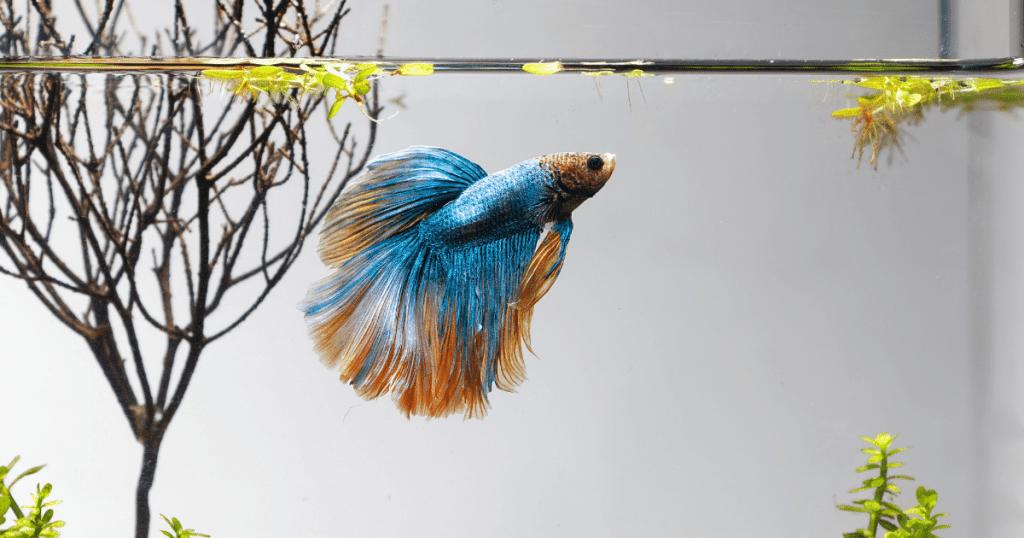
Bettas are some of the most low-maintenance fish you can find.
Not only are these fish stunningly beautiful, but they are easy to maintain as well (with proper care). Male bettas are known for having brightly colored bodies and long, flowy fins.
This species is known as the “Siamese Fighting Fish” and two males in the same tank may end up fighting each other to death. Although the males tend to be a bit kinder to female bettas and other species of fish, be cautious when introducing other fish to the tank.
Read more: Betta and Angelfish Compatibility Guide – Can They Live Together?
Bettas do best in a 5-gallon tank or bigger with an appropriate-sized filter and heater. They will tolerate cooler water, but they are tropical fish and prefer their water temperature to stay between 75-82°F.
Placing an appropriately sized filter in the tank is also important to not push your betta around the aquarium.
These fish don’t require a lot of food, as their stomachs are fairly small. Try to feed them Betta-specific pellets to ensure they receive enough nutrients. Here’s my write-up of the best Betta food you can buy.
With the proper care, bettas can live up to 2-5 years. For beginners looking for low-maintenance fish, a Betta is a great option.
- Size: Up to 3 inches long
- Lifespan in Captivity: 3-5 years
- Recommended Tank Size: 5 gallons or larger
- Recommended Water Temperature: 75-82℉ (24 to 28 Celcius)
Goldfish
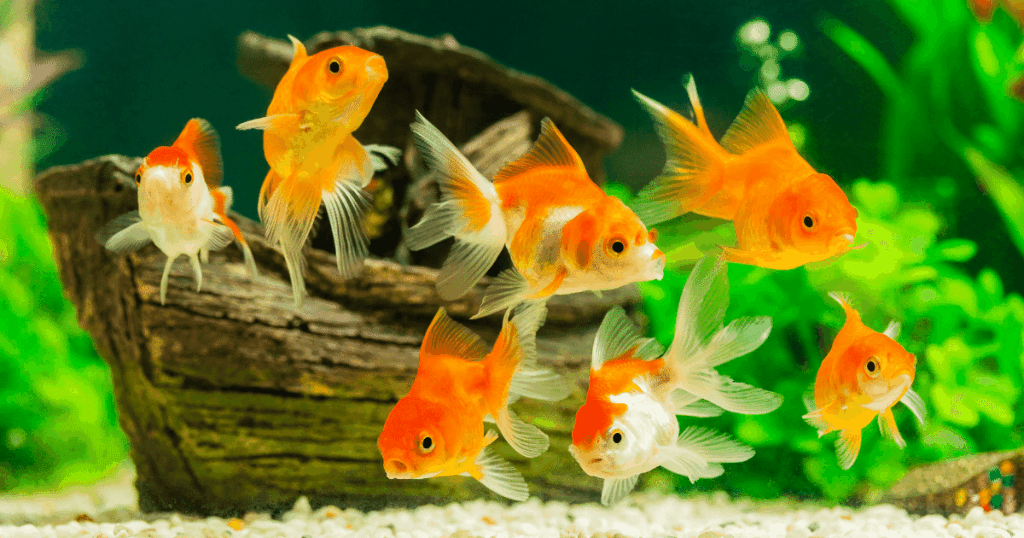
The Goldfish species is a very low-maintenance fish and is great for beginners.
There are many varieties of Goldfish. Some varieties can grow up to 14 inches long! This is why it is best to keep Goldfish in a 20-gallon tank or larger to start. Once they get bigger, you may need to consider upgrading to a larger tank.
And because they are a cold water species, they may not require a heater. Their ideal water temperature is 65-74℉.
Goldfish are generally messy and produce a lot more waste than most other fish. You will need a powerful filter to ensure their tank stays clean and to reduce toxic ammonia build-up.
A pelleted diet along with some soft plants will also reduce their waste and keep their tank slightly cleaner.
As long as you keep up with keeping the tank clean, you will have a happy and healthy Goldfish!
- Size: Between 8-24 inches long
- Lifespan in Captivity: 10-14 years
- Recommended Tank Size: 20 gallons or larger
- Recommended Water Temperature: 65-74℉ (18 to 23 Celcius)
Related: Why Is My Goldfish Turning Black? (Causes and How to Cure It)
Platies
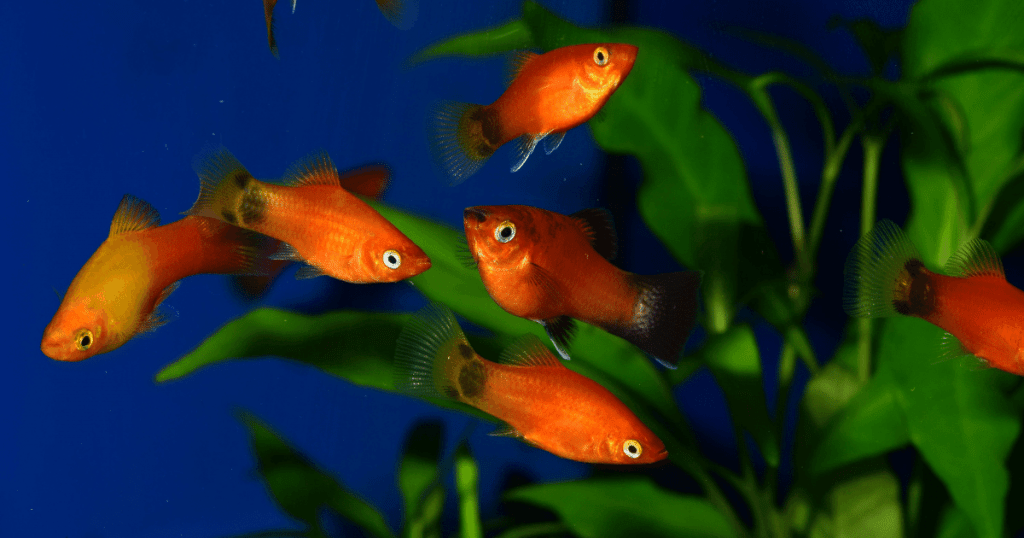
Platies are a beautiful, active, and easy-going species of fish.
They are one of the most low-maintenance fish and are very easy to care for. They come in many different colors and varieties.
These fish tend to school together and only grow to around 2 inches long.
Platies are livebearers and they breed very quickly and easily. They should be kept in a 10-gallon tank or larger for this reason and you may need to upgrade if your tank becomes overrun with babies.
These fish are not picky eaters and will eat almost anything you give them including frozen fish food, pellets or flakes, algae, and more.
These hardy little fish are a fun and active species and are a great low-maintenance fish for beginners.
- Size: Up to 2 inches long
- Lifespan in Captivity: 3-5 years
- Recommended Tank Size: 10 gallons or larger
- Recommended Water Temperature: 70-77℉ (21 to 25 Celcius)
Mollies
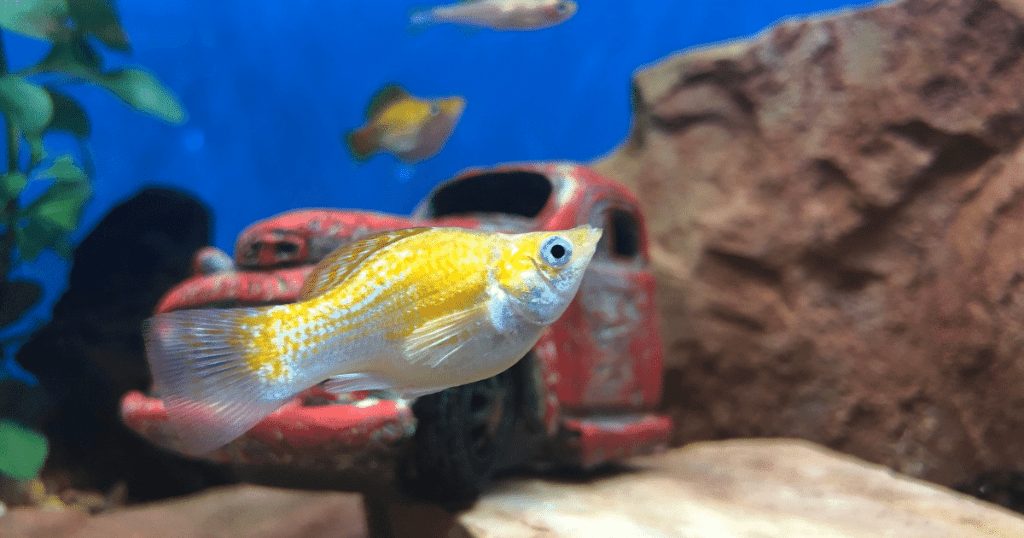
Mollies have the same characteristics as the Platies, however, they do have a few differences.
For instance, they prefer their water temperatures a little warmer, around 78-82℉. They also tend to get a bit larger, up to 4.5 inches long.
They too, come in many different colors and sizes. Like Platies, Mollies are also omnivorous and will eat almost anything including blanched vegetables, frozen fish food, pellets or flakes, algae, and more.
Mollies are also livebearers and they breed very quickly and easily. These fish should be kept in a 10-gallon tank or larger and you may need to upgrade if your tank becomes overrun with babies.
This is another peaceful species and is known to be gentle with tank mates. For this reason, Mollies are a great low-maintenance fish for beginners.
- Size: Up to 4.5 inches long
- Lifespan in Captivity: 3-5 years
- Recommended Tank Size: 10 gallons or larger
- Recommended Water Temperature: 78-82℉ (26 to 28 Celcius)
Neon Tetras

Neon Tetras are very common fish that are often kept in home aquariums.
And for good reason too.
These hardy little fish are beautiful and brightly colored. And their temperament is very calm and peaceful.
They prefer a tropical environment so a heater is most likely needed. Neon Tetras also thrive in soft, acidic water, and require a filter to help clean the tank.
Neon Tetras are schooling fish (or more accurately, shoaling fish), so you will want to house at least 6-10 Tetras in a 10-gallon tank or larger.
These fish are omnivores, so they prefer to eat micro pellets or flakes, along with some fresh live foods.
- Size: Up to 1.5 inches long
- Lifespan in Captivity: About 5 years
- Recommended Tank Size: 10 gallons or larger for 6-10 Tetras
- Recommended Water Temperature: 72-76°F (22-24 Celsius)
There’s also a ton of suitable Neon Tetra tank mates to choose from.
Zebrafish (Zebra Danio)
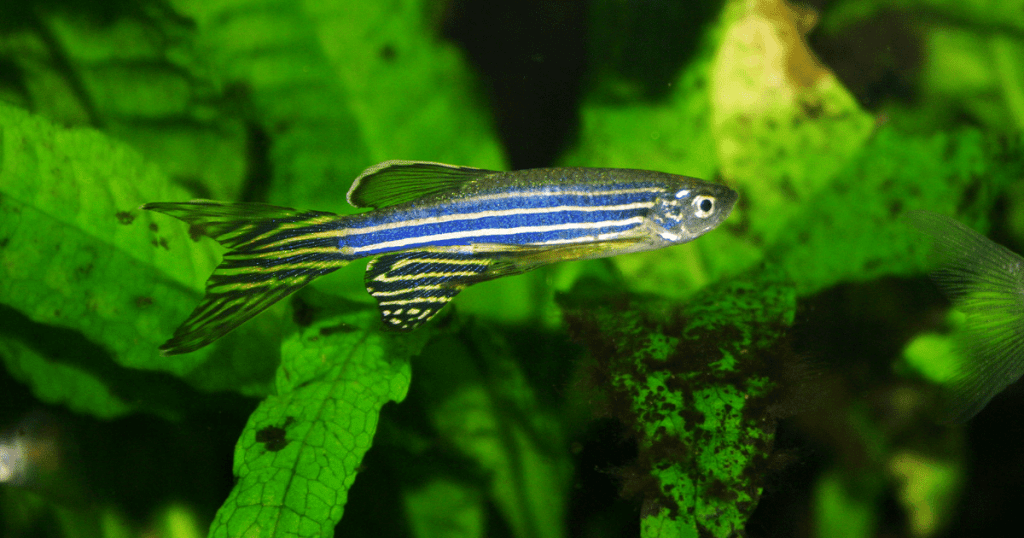
Zebrafish or Zebra Danios are small, adorable fish with horizontal stripes down their bodies.
This is a great low-maintenance fish for several reasons.
For instance, unlike the tropical fish that are kept in aquariums, Zebra Danios are cold-water fish that prefer room temperature water around 70°F (21°C).
So unless you live in an extremely cold region, you may not need a heater for these tiny little fish.
The best part is that Zebrafish come in various body colors and typically max out their size at around 2 inches long.
This fish likes to school in groups, so having a few types in your aquarium isn’t an issue. This active fish also needs a 10-gallon tank or larger so they have room to swim around.
Although these fish don’t require a heater, you will still need a decent filter to maintain a healthy tank. However, with the proper care, these fun-colored fish will provide loads of entertainment and are a joy to watch!
- Size: Up to 2 inches long
- Lifespan in Captivity: 2-3 years
- Recommended Tank Size: 10 gallons or larger for 5-10 Zebra Danios
- Recommended Water Temperature: 70-75℉ (21 to 24 Celcius)
Guppies

Guppy Fish are beautiful little fish that don’t need a very large tank to thrive.
Like most other fish, they require a proper filter and heater in their tank. Guppies are very active and will make any aquarium come alive.
These hardy fish can tolerate a wide range of water parameters, which makes them one of the best low-maintenance fish for beginners.
Guppies are omnivores and will eat almost anything you give them. While they can survive on flakes or pellets, it’s best to feed them a range of other foods such as blood worms, baby brine shrimp, insect larvae, and hard-boiled egg yolk.
They’re peaceful fish that get on well in a community tank. For example, Guppies and Neon Tetras make great tank mates.
Guppies are livebearers and they breed quickly and easily, even in poor water conditions. They can tolerate a 5-gallon tank, however, because they breed so readily, you should keep Guppies in a 10-gallon tank or larger for future Guppy babies.
- Size: Up to 1.5 inches long
- Lifespan in Captivity: 1-3 years
- Recommended Tank Size: 10 gallons or larger for 3 or more guppies
- Recommended Water Temperature: 76-82℉ (25 to 28 Celcius)
Corydoras
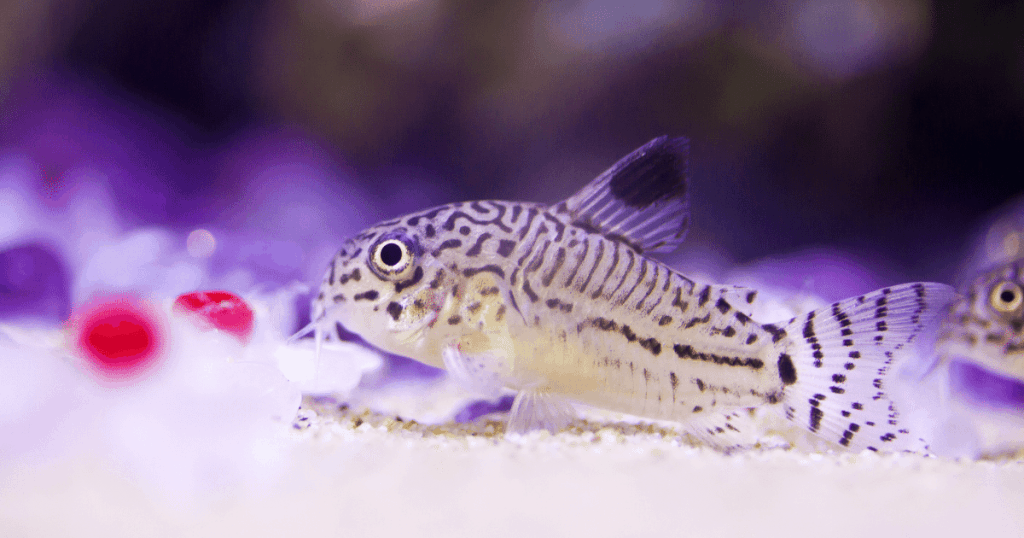
Corydoras are cute little catfish that move around on the bottom of your tank searching for food.
These hardy fish can tolerate a wide range of water conditions, making this one of the best fish for beginners. Water temperatures should be around 72-82℉ (22-28 Celsius) in their tank, and they do require a filter and heater.
Corydoras are fairly small and don’t require a lot of space, however, they should be kept in a minimum of a 20-gallon tank. This is another schooling fish, so it’s best to place 3-6 Corydoras in the same tank.
Because they’re bottom-feeders, Corydoras can make good tank mates for male Betta fish and others that feed at the surface. Feed them foods that will sink to the bottom of the tank such as sinking food tablets, shrimp pellets, and algae rounds.
- Size: Up to 4 inches long depending on the specific type
- Lifespan in Captivity: 12-15 years
- Recommended Tank Size: 20 gallons or larger for 3-6 Corydoras
- Recommended Water Temperature: 72-82℉ (22-28 Celsius)
Dwarf Gouramis

Related to the Betta, Gouramis are another low-maintenance fish for beginners to consider. There are many different types of Gouramis, but the Dwarf Gouramis are best for beginners as they stay fairly small.
Dwarf Gouramis can tolerate a 10-gallon-sized tank, but this is the minimum. If you plan to get multiple of these fish, it’s best to give them 20 gallons or more.
These fish are carnivores and should be offered a diet of insect larvae, fish flakes, freeze-dried foods, frozen foods, and vegetable tablets.
These hardy fish are both fun to keep and can live up to 6 years in captivity!
- Size: Up to 3 inches long
- Lifespan in Captivity: 4-6 years
- Recommended Tank Size: 10 gallons or larger
- Recommended Water Temperature: 75-78℉ (24-26 Celsius)
Dwarf Octocinclus
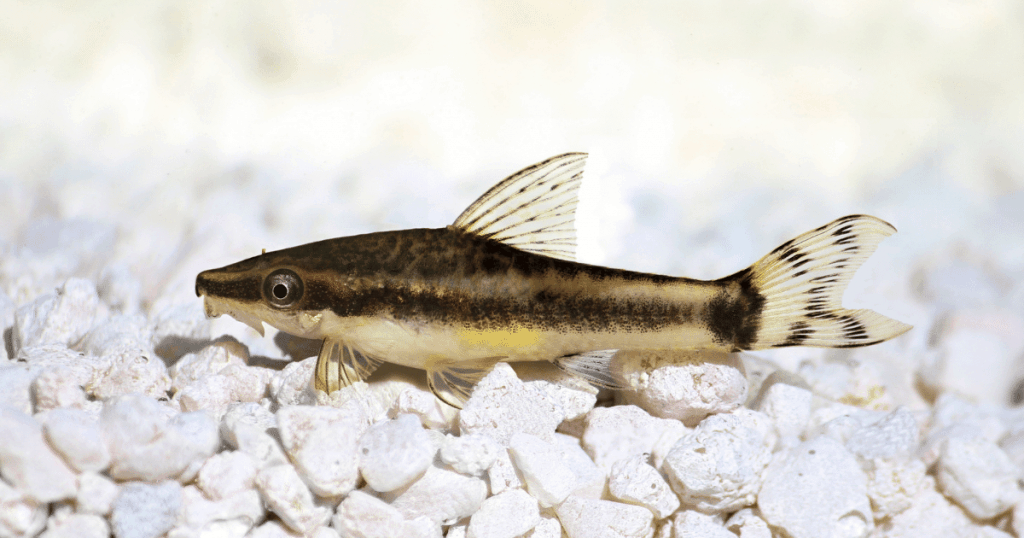
Like Corydoras, Dwarf Octocinclus is another small, schooling catfish that roams around the bottom of the fish tank looking for food.
These fish are extremely peaceful and are great low-maintenance fish for beginners.
Because they are schooling fish, you will want to keep at least 6-10 Dwarf Octocinclus in a 10-gallon tank or larger.
They also require a proper filter and heater, as they prefer the water temperature to stay between 72-82°F (22-28 Celsius).
Although these are bottom feeders, you should also provide them with a diet of algae wafers, Catfish pellets, and blanched vegetables.
- Size: Up to 1.5 inches long
- Lifespan in Captivity: 3-5 years
- Recommended Tank Size: 10 gallons or larger
- Recommended Water Temperature: 72-82°F (22-28 Celsius)
Best Fish for a Small Tank
Most beginner fish keepers tend to ask, “What is the best fish for a small tank?”
It’s important to understand that most fish require at least a 5-10 gallon tank. The best low-maintenance fish that tolerate a 10-gallon tank include:
- Betta Fish
- Platies
- Mollies
- Tetras
- Zebra Danios
- Guppies
- Dwarf Gouramis
- Dwarf Octocinclus
It’s also important to keep in mind that some of these species are livebearers and will rapidly breed under the right conditions.
Therefore a 10-gallon tank is a great starting place, but you may need to upgrade tank size depending on how many fish you plan to keep in the tank.
Make sure to do proper research on each species to ensure they receive the proper tank size and care.
What Fish Don’t Need Filters?
While searching for the best low-maintenance fish species, you may be wondering what fish don’t need filters.
The short answer is: All fish should have some sort of filter in their tank.
Filters in fish tanks help clean the water of excess waste, remove the build-up of toxic ammonia, and help fish breathe by aerating the water.
Excess waste in the tank can lead to many different health issues for your fish.
If you are looking to maintain a low-maintenance tank to start with, try using a beginner-friendly filter such as a sponge filter.
Sponge filters like the one pictured below are cheap, reliable, and easy to use, which is perfect for beginners.

Low-maintenance fish for a 5-gallon tank
If you have a 5-gallon tank and you’re looking for low-maintenance fish to stock it, you can do a lot worse than a male Betta. 5 gallons is much better than the tiny tanks and bowls they often get, and ideal for a solo male Betta.
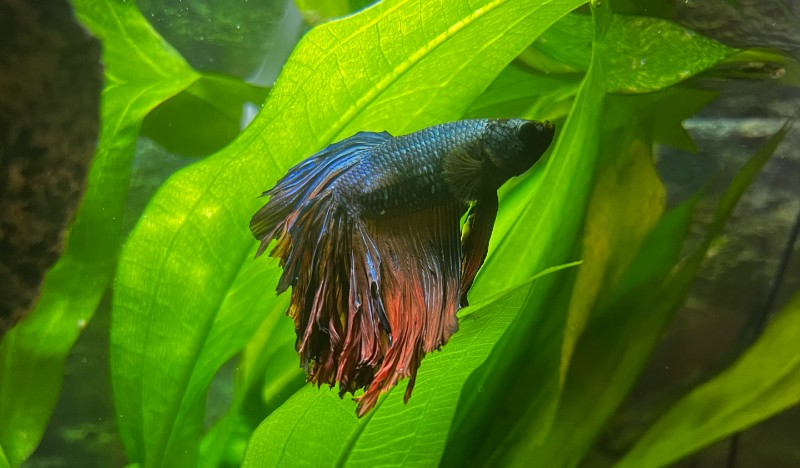
Bettas thrive in neutral pH water that’s between 75 and 80°F (24-26.5°C), so make sure you buy a suitable heater.
Feed protein-rich meat or insect-based foods like Fluval Bug Bites (my Betta’s personal favorite).
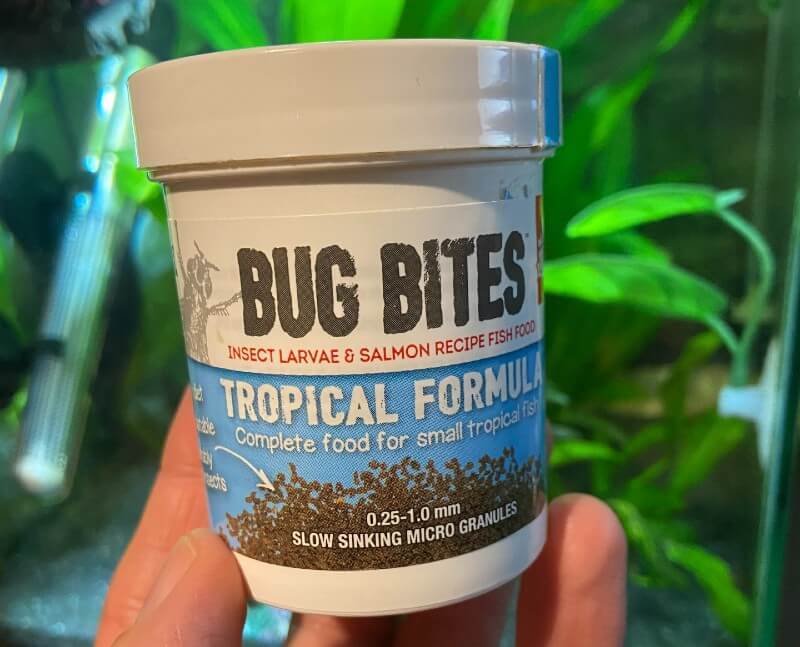
If Bettas aren’t your thing, you can also look at the following low-maintenance fish for your 5-gallon tank:
- Emerald Dwarf Rasboras
- Celestial Pearl Danios
- Guppies
- Red Cherry Shrimp
Low-maintenance fish for a 10-gallon tank
The Honey Gourami is one of the best low-maintenance fish, and is perfect for a 10-gallon tank. They grow to around 1.5 inches and their peaceful nature means they’ll get along with any other tank mates you want to put in your 10-gallon.
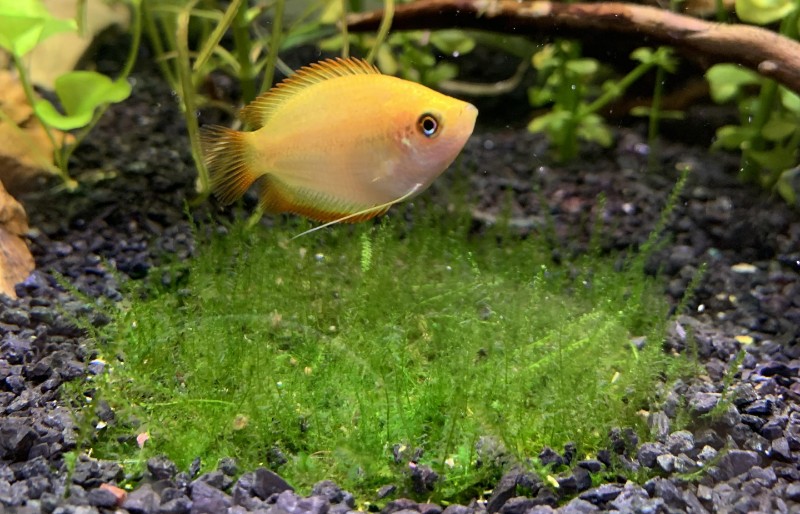
Honey Gouramis do well in heavily-planted tanks so they have some hiding places if they get a little scared or nervous. Keeping them in groups of 4 or more will make them feel safer and less likely to hide.
In a 10-gallon tank, 5 is the maximum number of Honey Gouramis I’d recommend. Any more and you’ll need to upgrade to a bigger tank.
They’re very hardy fish which makes them super low-maintenance. They can survive in a range of water parameters but aim for neutral pH. Honey Gouramis prefer water between 75 and 82°F (24-28°C).
Other options for a 10-gallon tank include:
- Platys
- Mollies
- Neon Tetras
- Cardinal Tetras
Read more: Fish that start with P
Low-maintenance fish for a 20-gallon tank
If you’re stocking a 20-gallon tank, one of the best low-maintenance fish you can choose is the Bristlenose Pleco. They’re very easy to care for and because they’re bottom-feeders and algae eaters, they’ll keep your tank clean too.
They do produce a lot of waste so it’s a good idea to keep them in a planted tank that can help with the extra bioload.
Aside from that, they don’t need a lot of attention at all. However, they’re so entertaining to watch that you’ll end up giving them lots anyway!
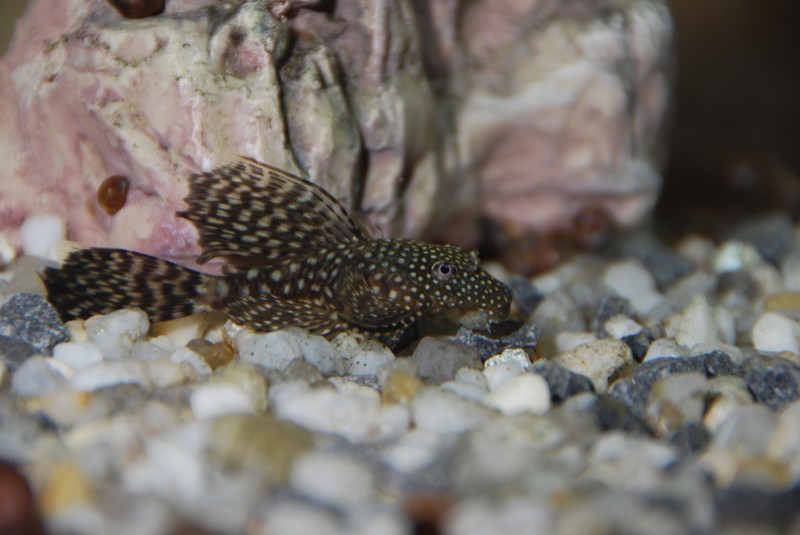
A 20-gallon tank gives you plenty of room for two Bristlenose Plecos, and if you get a male and a female you’ll have enough additional space in case they breed.
You can also consider:
- Electric Blue Ram
- Zebra Fish
- Apistogrammas
- Tetras
- Corydoras
Summary
I hope this article helped you decide which is the best low-maintenance fish for you.
All the species listed above are great options for beginners to get started with.
It’s important to keep in mind that although these fish are considered low maintenance, they still need an appropriately sized tank and proper care.
After all, no species of fish is completely hands-off!
However, if you give your fish lots of love and care, you could have a happy and healthy fish friend for years to come.
